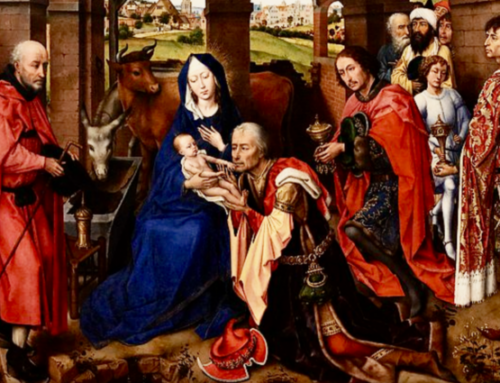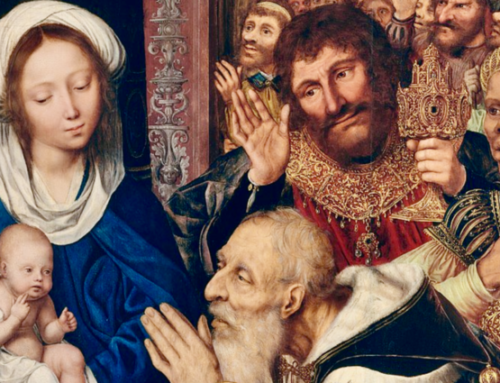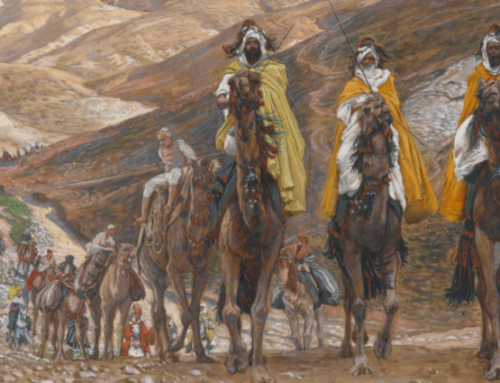Man may not live by bread alone, but a goodly baked bread goes a long way to rendering us joyful and content. Bread-making is both a sensual and spiritual experience. It satisfies a yearning for deeper bonding among friends and family, and it restores us to a less stressed, more thankful awareness of life.
 Many years ago, as a young diplomat straining to learn French, I was amused to realize that the French word for bread is spelled pain. Of course, it is not pronounced as such, but being steadfastly immature well into adulthood, I was nonetheless inclined to laugh each time I saw the word. For me, bread has always had a soothing, almost medicinal and certainly spiritual, aspect to it. It was the furthest thing from pain; indeed, it is nearly pain’s antithesis. Man may not live by bread alone, but a goodly baked bread goes a long way to rendering us joyful and content. This is especially true for breads we make on special occasions, particularly Christmas, where the aroma of fresh yeast, flour, and cardamom blend perfectly with the other familiar smells—wreaths, fir trees, and candles—of that holiday. Together, they render me emotionally intoxicated and spiritually renewed.
Many years ago, as a young diplomat straining to learn French, I was amused to realize that the French word for bread is spelled pain. Of course, it is not pronounced as such, but being steadfastly immature well into adulthood, I was nonetheless inclined to laugh each time I saw the word. For me, bread has always had a soothing, almost medicinal and certainly spiritual, aspect to it. It was the furthest thing from pain; indeed, it is nearly pain’s antithesis. Man may not live by bread alone, but a goodly baked bread goes a long way to rendering us joyful and content. This is especially true for breads we make on special occasions, particularly Christmas, where the aroma of fresh yeast, flour, and cardamom blend perfectly with the other familiar smells—wreaths, fir trees, and candles—of that holiday. Together, they render me emotionally intoxicated and spiritually renewed.
For others, I am sure, the smell of hot chocolate or eggnog or a roasting ham may conjure up warm feelings and inner stirrings, and perhaps equally pleasant memories. But my memories of the special cardamom bread we bake every Christmas Eve are my fondest of each Christmas season. I think part of the reason for this is because while breaking bread together is a great goodness, it cannot rival making bread together. If St. Augustine was right that “he who sings prays twice,” then those who make bread together while singing certainly pray thrice. Gathered around the kitchen table each Christmas Eve as carols are sung, choosing partners for “shaping” the dough into various designs, arguing over just how to knead the dough and how much flour to add, worrying about over-cooking and under-cardamoming the bread, all blend into a tattered tapestry of love and joy.
The first time I ever made this bread was with my almost wife, Sharon, back on Christmas Eve 1981. I say almost wife because we were to be married two days later on the Feast of Stephen (always the most depressing day of the year for me, thus my feeble attempt to make it cheerful as our anniversary). She had just flown up from Ethiopia and as we settled into my small apartment in Cairo, she was understandably stressed and nervous about getting married to me. We hadn’t seen each other for many months, since we had left Washington, D.C. for our respective assignments overseas, and mail in those days was erratic and trying to make a phone call from Cairo to Addis via London was laughably Kafkaesque. But there we were together alone in a foreign land among strangers, two days from getting married to people who were essentially also strangers. It was the making of that cardamom bread that night that soothed her and calmed me and brought us back to where we were months earlier.
In an effort at full disclosure, I should add that the actual breaking of the bread was not as pleasant as the making of it. The next day we had Christmas dinner at my boss’s house, and we proudly brought along one of the loaves we had baked into the shape of a Star of David. It was enchanting to look upon and we were certain it would be the hit of the dinner party. So, we were both crestfallen when the bread arrived from the kitchen, already chopped into little pieces and flagrantly tossed into a dull bread basket as if it were mere bread! “Philistines,” I muttered under my breath in a very unChristmasy manner.
Since that first baking experience, we have continued the tradition for 37 years in eight countries without fail. In some places, such as the Philippines and Cambodia, we would invite the Marines who guarded the embassy to join us in making the bread. Although they generally seemed more interested in my then-teenage daughter Alessia than in the making of the bread, it was always a happy, laughter-filled occasion. Another time, in Morocco, it was the Marines who came to our rescue when our oven ran out of gas and we had to hurriedly transport the partially-done bread to the Marine House down the block in order to complete the baking. Yet other times, we invited the single people in the embassy, living so far from family, to join us, or else just a few close friends with whom we dared to share such an intimate gathering. And, of course, sometimes just us, gathered around the table singing, arguing, kneading, shaping, laughing, baking.
Thankfully, over the years, we have resolved most of the serious conflagrations. We all now more or less agree that a slightly under-baked bread is far superior to even a slightly over-baked one. Same with flour: less is more. Better that the dough remain sticky and hard to handle than to be over-floured. We also now agree that while cardamom is the key ingredient, one can have too much of a good thing. Alessia learned the truth of that axiom the hard way while at college when she decided to add four times the amount of cardamom that the recipe calls for, hoping that it might quadruple the wonderful taste of the bread. A costly lesson, although we do now all agree that the recipe is too parsimonious with the cardamom and that an extra smattering enhances the finished product. Finally, we have resolved when and how much to eat, simply by doubling the recipe each year now, making six rather than a meager three loaves; one to eat Christmas Eve night right after Mass, one for Christmas morning (after checking out stockings, but before opening gifts), one or two for Christmas dinner, another for the Feast of Steven, and usually one reserved frozen for New Year’s.
On the other hand, some arguments are simply implacable and even the spirit of Christmas cannot resolve them. The most serious is the perennial conflict between traditionalists and iconoclasts when it comes to shaping the bread. The original recipe came with half a dozen properly vetted and approved shapes, such as a five-pointed star and a four-wheeled pinwheel. But over the years other forms have been shamelessly, heedlessly, even impudently added, allowing younger shapers the chance to use their creativity to make new designs, some succeeding spectacularly and some failing utterly.
There is more than a little truth to the Spanish phrase, Las penas con pan son buenas—with bread, bad things become good things. Like love-making at its very best, bread-making is both a sensual and spiritual experience. It should satisfy all five senses: The smell of the yeast and cardamom, the tactile delight of the sinewy dough, the satisfying thump of the dough onto the counter, the heavenly taste of freshness, and the delightful visual of a well-shaped loaf. But it also satisfies a yearning for deeper bonding among friends and family, and it restores us to a less stressed, more thankful awareness of life.
Christmas Eve Bread Recipe
- 2 pkg yeast
- ¼ cup warm water (105-115 degrees)
- 1 ½ cup lukewarm milk
- 1 cup sugar
- 1 teaspoon salt
- 1 or more teaspoon ground cardamom
- 4 beaten eggs
- Up to 8 cups flour
- ½ cup melted unsalted butter
- Sprinkle yeast on the warm water and let stand a few minutes, then stir to blend. Blend in milk, sugar, salt, cardamom and eggs; then stir in 2 cups flour.
- Add 3 more cups flour and beat the mixture until smooth.
- Stir in melted butter.
Add just enough of the remaining flour to make a soft dough. Let rest 15 minutes. Turn out on very lightly floured board and knead until smooth and elastic. Place in large, warm greased bowl; turn greased side up. Cover with a damp towel and allow the dough to rise until doubled, about 1 hr. Punch down gently and allow to rise again until almost doubled, about ½ hour. Turn out onto the board, divide into three portions, and shape.
After shaping into three designs, allow bread to rise another 20 minutes or so, until puffy but not doubled. Bake at 375 for 15-20 minutes or until very lightly browned. The other shapes can be left in the refrigerator overnight and baked the next day.
The Imaginative Conservative applies the principle of appreciation to the discussion of culture and politics—we approach dialogue with magnanimity rather than with mere civility. Will you help us remain a refreshing oasis in the increasingly contentious arena of modern discourse? Please consider donating now.
The featured image is “Bread Baking” (1889) by Anders Zorn, and is in the public domain, courtesy of Wikimedia Commons.







Thanks! This is the, Finnish Nissua, sweet bread of my childhood! My mother, her sisters , and all those who visited, known as “company”, shared in eating and making this wonderful bread served with coffee. At Easter, hot cross buns were made from this dough with the added powder sugar frosting cross placed on top to eat on Easter morning. Great memories.
Everyone try this bread, it will not disappoint!
Oh! Thanks, Kat. I never knew a name for the bread, but had been told it was from somewhere in Scandinavia. Maybe at Easter we will try it, too. Merry Christmas. Joe